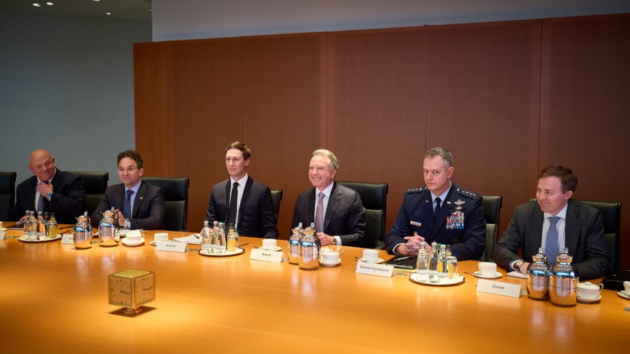Trump and Harris both want a manufacturing boom. They have very different plans for doing it.
Written by ABC Audio. All rights reserved. on October 3, 2024
(NEW YORK) — In the final weeks of the campaign, former President Donald Trump and Vice President Kamala Harris have sought to best each other on the all-important issue of the economy, which many voters rank as their top concern.
Both candidates have made manufacturing a centerpiece of their plans, but their respective approaches feature stark differences.
Harris aims to close corporate tax loopholes and throw government support behind the production of critical goods. By contrast, Trump wants to protect domestic manufacturers with tariffs on foreign products while cutting corporate taxes and easing regulations.
Manufacturing accounts for about 10% of U.S. gross domestic product and an even smaller share of the nation’s jobs. But the sector bears outsized importance since the production of essential goods holds national security implications and many manufacturing workers live in key swing states, experts said.
“There’s a belief that manufacturing is special,” Mary Lovely, a senior fellow at the Peterson Institute for International Economics who studies trade policy, told ABC News.
Here’s what to know about where Harris and Trump stand on manufacturing, and what experts think of their respective plans:
Trump: Tariffs and corporate tax cuts
On the campaign trail, Trump talks about tariffs more than just about any other policy proposal. The tax on imports makes up a key part of his plan for revitalizing manufacturing, alongside a lower tax burden for companies that he says would boost production and hiring.
Trump has promised a sharp escalation of tariffs enacted during his first term. Trump has proposed tariffs of between 60% and 100% on Chinese goods. A set of far-reaching tariffs would also include a tax as high as 20% on all imported products.
In theory, a tax on imports would give domestic producers a leg up in competition with foreign manufacturers, Christopher Conlon, a professor of economics at New York University who studies trade, told ABC News.
“His plan is based on the idea that foreign competitors are pricing their products too low and what we need to do is erect a wall of tariff barriers around the U.S.,” Conlon told ABC News.
An escalation of tariffs could expand certain areas of U.S. manufacturing vulnerable to foreign competition, which could result in added jobs at companies protected by the policy, experts said.
The economy added manufacturing over the first few years of his presidency, though the pandemic wiped out much of those gains.
Experts cautioned about a spike in input costs and consumer prices that could end up hindering many manufacturers and hammering household budgets. Evidence indicates that the Trump tax cut did not provide a significant boost for the economy, they added.
U.S. manufacturers of sophisticated products like automobiles and advanced medical equipment often import raw materials. A tariff would likely raise costs for those companies and risk making them less competitive on the global market, Conlon said. While adding jobs at some manufacturers, the policy could cause layoffs at others.
“Nobody seems to have shared that wisdom with the Trump campaign,” Conlon said.
A similar cause and effect applies to prices paid by everyday people for imported goods at the grocery or department store. Broad tariffs on foreign goods would likely force importing companies to raise prices and reignite inflation, experts said.
In a statement to ABC News, the Trump campaign said its manufacturing plan would create jobs and cut taxes.
“President Trump is a businessman who built the greatest economy in American history, and certainly doesn’t need economics lessons from a professor who has never created jobs or built anything in his life,” Trump campaign spokesperson Karoline Leavitt said.
“President Trump successfully imposed tariffs on China in his first term AND cut taxes for hardworking Americans here at home — and he will do it again in his second term. President Trump’s plan will result in millions of jobs and hundreds of billions of dollars returning home from China to America,” the statement added in part.
Harris: Close tax loopholes and provide government support
Harris has proposed a different approach to manufacturing that emphasizes closing tax loopholes for some large corporations and providing government support for high-priority areas within the sector.
The agenda carries over a key part of the strategy undertaken by the Biden administration, which invested billions into manufacturing through a series of measures focused on bolstering key industries.
The Inflation Reduction Act spent hundreds of millions of dollars to boost U.S. production of renewables as the nation pursues ambitious carbon emissions goals and a supply chain less dependent on China. While the CHIPS and Sciences Act infused tens of billions into the production of semiconductors.
“The Biden administration has picked sectors, and in those sectors companies are eligible for assistance,” said Lovely.
Last week, Harris put forward a plan calling for $100 billion investment in manufacturing to further bolster the sector. The policy would prioritize “industries of the future,” such as carbon-efficient steel production and data centers for artificial intelligence, the campaign said in a statement last week.
The Harris campaign said it aims to pay for the investment with a reform of the international tax code that prevents producers from skirting U.S. taxes in a “race to the bottom.”
“The facts are clear: When he was president, Trump lost nearly 200,000 manufacturing jobs and created new incentives for companies to ship American jobs to China. Economists warn if Trump takes power again, his policies will crush American manufacturing jobs, send even more jobs to China, and cost middle class families $4,000 a year. This is a fundamental contrast with Vice President Harris, who is leading an American manufacturing boom – creating jobs right here at home and outcompeting China,” Harris campaign spokesperson Joseph Costello said in a statement to ABC News.
It remains unclear whether the support for manufacturing provided by the Biden administration has yielded significant gains in output or jobs, experts said.
The measures, however, have elicited a burst of factory construction. Spending on manufacturing-related construction surged from $76.4 billion in January 2021 to $238.2 billion in August 2024, U.S. Census Bureau data showed.
The surge in construction marks a positive signal but the critical test will be whether the plants deliver strong output and well-paying, long-term jobs, said Conlon.
“We haven’t had enough time to see if there’s a real effect or not,” he added. “How many chips are getting built by these plants? We don’t know that yet.”
Copyright © 2024, ABC Audio. All rights reserved.





